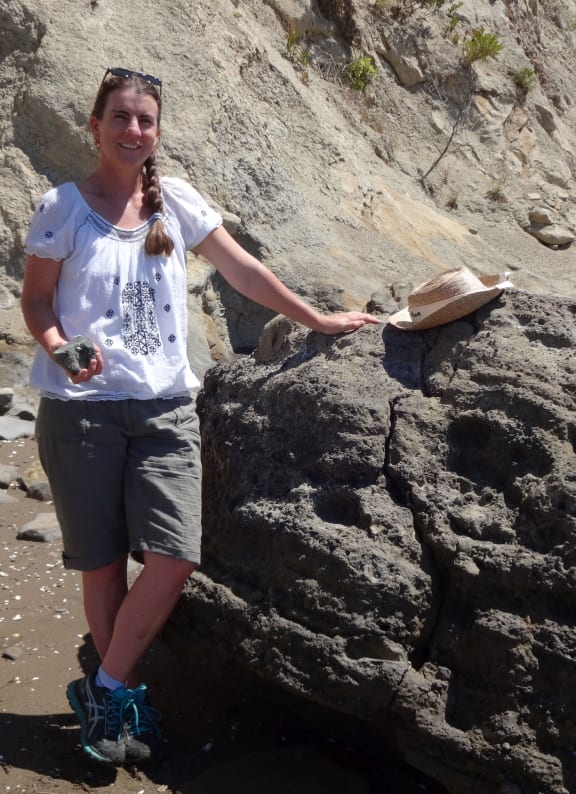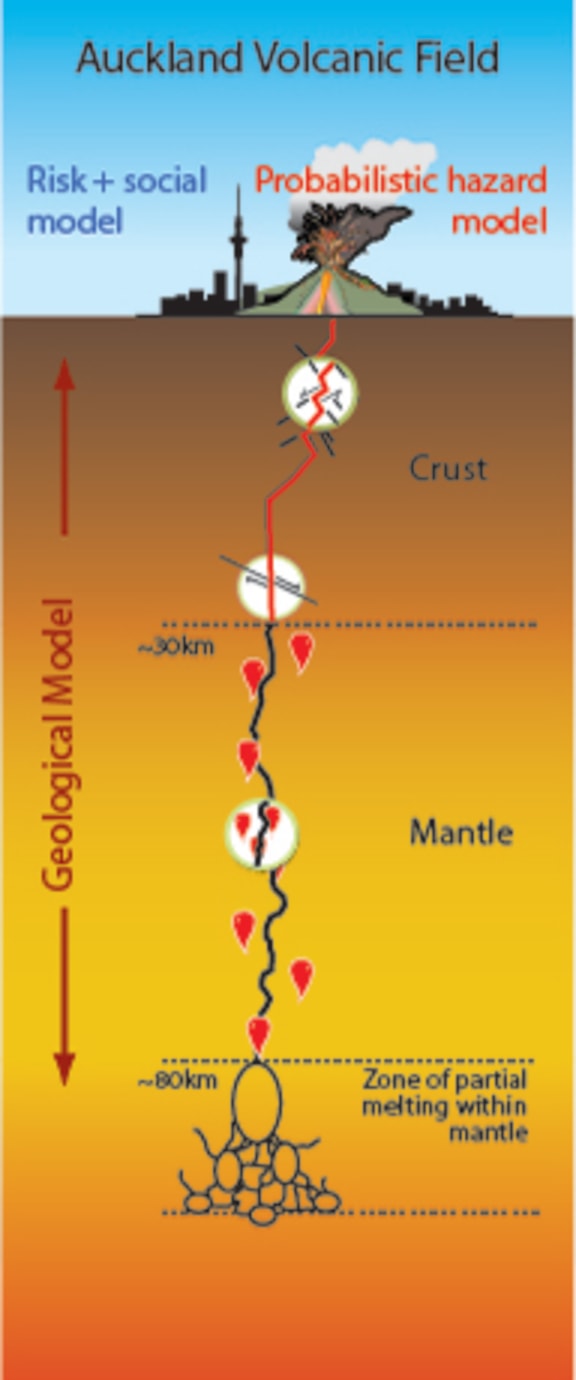By Veronika Meduna Veronika.Meduna@radionz.co.nz
'There’ve been 53 to 55 volcanoes that formed in the Auckland Volcanic Field over the past quarter of a million years. They haven’t occurred regularly … it looks like there were a few eruptions in the beginning and then ... in particular around 30,000 years ago it seems there were quite a number of eruptions occurring within a period of just a couple of thousand years. After that it got quiet again.' - Jan Lindsay, volcanologist

Jan Lindsay at Ladies' Bay, in St Heliers, where she is checking boulders that have been deposited by a volcanic eruption more than 50,000 years ago. Auckland's youngest volcano Rangitoto is in the background. Photo: RNZ / Veronika Meduna
Our largest city is built on top of an active volcanic field that has erupted at least 53 times over the last 250,000 years, often in devastating explosions that felled forests and spewed fountains of fire.
Geologists expect that more volcanoes will erupt beneath Auckland in the future, and that each new explosion will emerge through a completely new vent. What that prospect means for the metropolitan area is the focus for the seven-year DEVORA project, which brings together geologists, city planners and civil defense staff to work out a strategy to protect people and infrastructure.

Jan Lindsay is a co-leader of the DEVORA project. She grew up in Rotorua, Western Samoa and Auckland - all places known for their volcanoes. Photo: RNZ / Veronika Meduna
University of Auckland volcanologist Jan Lindsay, a co-leader of the DEVORA project, looks at Auckland’s landscape through the lens of the city’s volcanic history. Along the beach at Ladies’ Bay, in the suburb of St Heliers, she studies deposits of a violent explosion that happened more than 50,000 years ago, firing boulders from the Glover Park volcano.
“When the magma reached the surface and came into contact with groundwater or shallow surface water, or just muddy sediments, it caused a big explosion,” she says. The magma and the surrounding rock were blasted into millions of pieces, ranging from a few centimeters to a metre in diameter, including huge “chunks of the basement rock that have been ripped out by the magma and thrown out of the volcano”.
Glover Park exploded in what geologists know as a phreatomagmatic eruption. “The word phreatomagmatic means steam and magma essentially. When magma comes into contact with water, the eruptions are often far more explosive than if magma just emerges passively at the surface. So the water acts as a catalyst.”
These powerful blasts not only shatter everything in their way, but also drive destructive base surges that can travel up to five kilometres from the vent. “That’s the worst case scenario in an Auckland situation,” says Jan Lindsay.
The size and nature of the deposits at Glover Park suggest that this was an average eruption and probably ran out for about two kilometres in radius. “But it would still have been devastating. Don’t forget, the vent itself is about a kilometre wide – that’s a hole in the ground that wasn’t there before.”

This diagram shows how magma travels up from the ductile mantle until it hits more brittle rocks, which generates small earthquakes. Photo: DEVORA
The Glover Park volcano erupted during a period when sea levels where much lower than today and Jan Lindsay says that given changes in Auckland’s geology since then, it makes it even more likely that a future eruption would be explosive.
'Looking at past deposits in the Auckland Volcanic Field, we know that about 80 to 85 per cent of all of the eruptions had a phreatomagmatic component, so an explosive base surge … usually at the start of the eruption. Sea levels are now much higher and hydro-geological conditions have changed, with groundwater concentrated in many parts of Auckland close to the surface ... . It’s safe to say that we’re in a wet period of the Auckland Volcanic Field so any future eruption we would certainly expect to have a phreatomagmatic component.'
Auckland’s youngest volcano Rangitoto seems to be an exception. Geologists thought that it formed during an eruption some 500 years ago, but by analysing sediment cores from the nearby Lake Pupuke, University of Auckland geologists Phil Shane and Paul Augustinus have discovered that the volcano erupted intermittently or almost continuously from about 1500 to 500 years ago.
Last year, the team drilled deep into Rangitoto Island's lava to piece together its eruption history in more detail.
As the DEVORA project is about to wrap up, Jan Lindsay says the team now has a fair idea of what a future volcanic eruption would mean for Auckland. Unlike earthquakes, volcanoes are likely to give some warning, and there are 11 seismometers throughout the city, all part of GNS Science’s GeoNet project, that monitor underground tremors.
The magma below Auckland is generated in the mantle, probably about 100 kilometres below the city, and the mantle is ductile. “It will have to travel quite a distance through the ductile mantle before it reaches brittle rocks to generate earthquakes. It may not generate earthquakes until it’s at 30 to 40 kilometres depth so it may well travel half of its distance before we pick up on it. But then, we hope that we’ll start seeing little earthquakes at depths and we should see them shallowing, and we can tell when and where the magma will reach the surface.”
Jan Lindsay says that although a volcanic eruption in Auckland would be a massive challenge, it is likely going to affect only a relatively small area. “It’s just that that particular area might well be in a built-up environment so it becomes obviously very important to get everybody out in time and we fully anticipate that we’ll have enough warning to be able to do that.”

